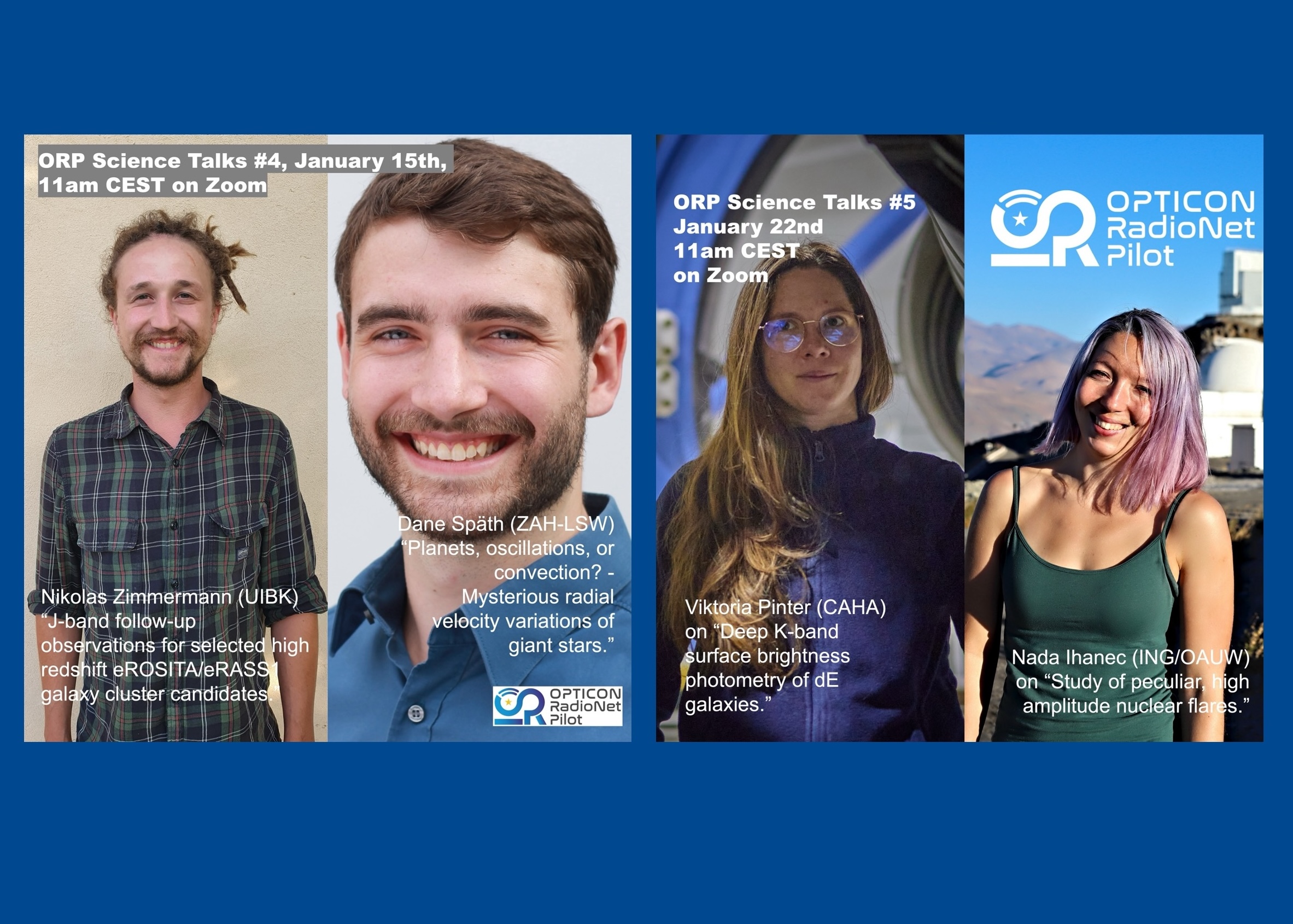
The fourth and fifth sessions of the ORP Science Talks will take place on January 15th and 22nd, respectively, at 11:00 AM CEST via Zoom. You are welcome to join by clicking here!
In Session 4, Nikolas Zimmermann (UIBK) will present “J-Band Follow-Up Observations for Selected High-Redshift eROSITA/eRASS1 Galaxy Cluster Candidates”. He will be followed by Dane Späth (LSW ZAH, Uni Heidelberg), who will discuss “Planets, Oscillations, or Convection? - Mysterious Variations in the Radial Velocity of Giant Stars”.
In Session 5, Viktoria Pinter (CAHA) will speak on “Deep K-Band Surface Brightness Photometry of dE Galaxies”. She will be joined by Nada Ihanec (ING/OAUW), who will present “Study of Peculiar, High-Amplitude Nuclear Flares”.
ORP Science Talks take place approximately every month on Zoom, providing the community (ORP and hopefully beyond) with the opportunity to present their work and scientific results. ORP members, share feedback on the ORP Science Talks or nominate yourself as a speaker at this virtual meeting with an email to outreach@orp-h2020.eu.
View recordings of the talks from the previous three sessions here, here, and here.
Short descriptions of the next speakers' talks:
Session 4
Nikolas Zimmermann (UIBK)
J-Band Follow-Up Observations for Selected High Redshift eROSITA/eRASS1 Galaxy Cluster Candidates.
eROSITA is a space based telescope searching for X-ray luminous galaxy clusters and is expected to detect clusters beyond redshift z~1. A robust and pure sample including such high redshift objects yields powerful cosmological constraining power regarding the cosmological growth of structure. Clusters in such large surveys (eRASS1: eRosita All Sky Survey - data release 1) are confirmed and characterised by optical follow-up observations in filters which straddle the 4000 Angstrom break in galaxy SEDs. As we move to higher redshifts (z>1), the 4000 Angstrom break is shifted into the near infrared (NIR) regime, thus confirmation and characterization require additional NIR imaging. During the past year 3 observation runs at the Calar Alto Observatory were conducted, observing a selection of high redshift eRASS:1 galaxy cluster candidates. The data for significant over-densities in different colours at supposed galaxy cluster positions were analysed in order to confirm a cluster candidate and, if successful, estimate its photometric redshift.
Dane Späth (ZAH-LSW)
Planets, oscillations, or convection? - Mysterious radial velocity variations of giant stars.
Planets orbiting evolved stars provide a unique opportunity to explore systems in higher stellar mass regimes and investigate the impact of stellar evolution. However, recent studies have refuted several planets around very luminous giants, attributing their signals to poorly understood intrinsic stellar processes, such as non-radial oscillations or variable levels of convection.
In this talk, strategies for differentiating true planetary companions from intrinsic stellar signals in giant stars will be presented. It will be shown that non-radial oscillations can explain at least one false-positive planet detection. Using nearly 25 years of radial velocity data from the Lick, SONG, and CARMENES spectrographs, ten evolved planet candidates are investigated, aiming to confirm their planetary nature or uncover the stellar origins of their radial velocity variations. These findings highlight the critical role of long-term observations in reliably identifying planets around evolved stars.
Session 5
Viktoria Pinter (CAHA)
Deep K-band surface brightness photometry of dE galaxies
Dwarf elliptical galaxies (dEs) are the most abundant type of galaxy in the Universe. Research into these objects and their connections with late-type dwarf galaxies is important for understanding theories of dwarf galaxy formation and evolution. We analyzed 141 dEs, examining their surface brightness profiles (SBPs) across four environments using near-infrared Ks-band data. For the first time, Ks apparent magnitudes were obtained for 67 galaxies, along with other physical parameters for 91 objects. Correlations between these parameters revealed a separation between dEs in different environments. The fundamental plane(FP) for dEs was constructed and compared with the FP for star-forming dwarf galaxies, suggesting no evolutionary link between the two classes.
Nada Ihanek (ING/OAUW)
Study of peculiar, high amplitude nuclear flares
In recent years large all sky surveys have discovered more and more high amplitude flares from the centres of galaxies, both active and quiescent. A variety of mechanisms have been proposed to explain such events, from Tidal Disruption Events, Bowen Fluorescence Flares, Changing Look Quasars or Microlensing Events. Gaia has been observing the whole sky since 2014 and is particularly good at detecting long-term high amplitude flares. Up until now, Gaia Photometric Science Alerts has discovered more than 25000 transients, around 10% of them being localized in centres of their host galaxies. We have preformed a study on those nuclear transients, focusing on >0.5mag flares and obtained spectroscopic and photometric follow -up. In the talk I plan to present the current status of the project and the most interesting examples of high amplitude flares.